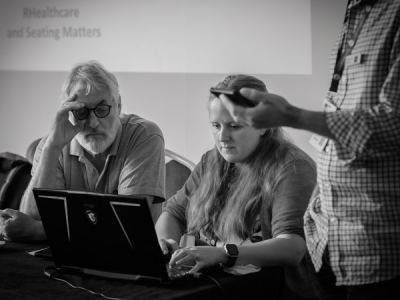
Transportation of people seated in wheelchairs: providing evidence of the limit of tilt for forward facing transport
Presenters: Bob Appleyard and Vicky Curling (photograph courtesy of Clinton Davin)
Being relatively new to the world of posture and mobility, I was very fortunate and grateful to be offered a bursary to attend the PMG Conference 2023 in Telford.
I am a rehabilitation engineer (RE) working for a specialist seating service within the NHS. Attending the conference has been a huge benefit to my career development, enhancing my product knowledge amongst several other things, and has helped improve the outcome for patients I prescribe seating for.
The session at the event that had the biggest impact on me was the session led by Bob Appleyard and Victoria Curling, titled Transportation of people seated in wheelchairs: providing evidence of the limit of tilt for forward facing transport, which provided evidence on the limit of wheelchair tilt, and the need to adopt rearward facing occupancy in vehicles.
The process of performing risk assessment and management around a difficult case was discussed. The presenters spoke about the abdominal intrusion and blunt trauma sustained by an occupant of a wheelchair in the event of a collision, and how this could be significantly reduced by altering the method of securing in the vehicle. The presentation has left a long-lasting impression on me; how making one small change can have a huge impact on safety.
A dynamic test rig was used to run several different tests, using a wheelchair set at varying amounts of tilt and recline, with a simulated 10G/30KmH collision, using a 77kg test weight. This test setup is less severe than the setup typically used for a standard car crash test.
A test was conducted using 20 deg of tilt and 20 deg recline, with the standard tie down points of the wheelbase used for the securing. The video footage of the test indicated the following worrying problem: as the wheelchair was securely fixed to the test rig, the impact caused movement in the test subject, which resulted in abdominal intrusion and blunt trauma injuries.
Footage was then shown of the test being repeated with the same wheelchair setup; however, the method of securing the wheelbase was altered. A K12 buckle (this is the standard buckle seen on seatbelt systems) was mounted directly onto the wheelbase, and this was used to secure the wheelchair to the test rig. With this small, low- cost change implemented, the wheelchair, rather than the test subject, was seen to move at the point of impact, resulting in no evidence of abdominal intrusion or blunt trauma injuries. This showed the massive benefits obtained from this mounting option, and how managing the path of the load applied to the occupant during a collision should be an essential consideration for wheelchair tie-down while in transport.
This has led me to wonder where and how this can be progressed further, and has raised several questions in my mind. Implementing this mounting method as a standard would take a great deal of research and development, and who should be responsible for progressing this further?
The session generated a good discussion surrounding the responsibility of wheelchair manufacturers, given this new knowledge. It would be challenging for the research and development departments of all the various manufacturers to work in unison to achieve a standard; however, in the absence of any standards, they may be less likely to make changes to their current systems and develop mounting methods while there are no standards in place.
I believe that standards should be developed and put in place, to give manufacturers a consistent approach to developing and manufacturing their own wheelchair products, ensuring that a ‘one size fits all’ system is developed and put in place. This would result in a much safer wheelchair transportation experience for users. The presenters made several references to PMG’s Best Practice Guideline, Transportation of People Seated in Wheelchairs, and this is a valuable resource for me as an RE; I hope that updates can be made to this document now that there is further information available.
NB You are invited to submit comments on the above-mentioned Transportation of People Seated in Wheelchairs via https://www.pmguk.co.uk/resources/best-practice-guidelines/transportation-please-feel-free-to-add-your-comments
Ed.






.jpg)



no comments
Add your comment...